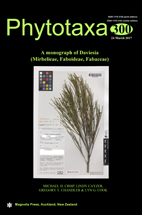Abstract
Daviesia is a clade of scleromorphic shrubs that are endemic to Australia and its near offshore islands, where it is the largest genus of Fabaceae subfam. Faboideae, with 131 species recognised here. The genus is distributed throughout the continent and occurs in all major habitats except wetlands, rainforest and the alpine zone. This is the first monograph of the genus published since Bentham’s in 1864, which included only 55 species. New taxa described herein are D. divaricata subsp. lanulosa, D. filipes subsp. terminalis, D. subulata, D. schwarzenegger and D. scabrella. New combinations with a change of rank are D. aphylla, D. decurrens subsp. hamata and D. implexa, while D. devito is raised from subspecies level and given a new epithet. A key to species and subspecies, detailed comparative descriptions, phenology and habitat information, as well as line drawings or photographs, are presented for all species. Conservation status is given for taxa of concern, mostly based on assessments by government agencies. A new molecular phylogenetic analysis using sequences of chloroplast and nuclear ribosomal DNA is presented and used to arrange the species descriptions, where the 13 unsequenced species are interpolated using morphological similarity. Seven strongly supported clades and seven mostly well-supported subclades are named informally for reference in discussion of affinities, but are not formally described because they lack morphological synapomorphies.

